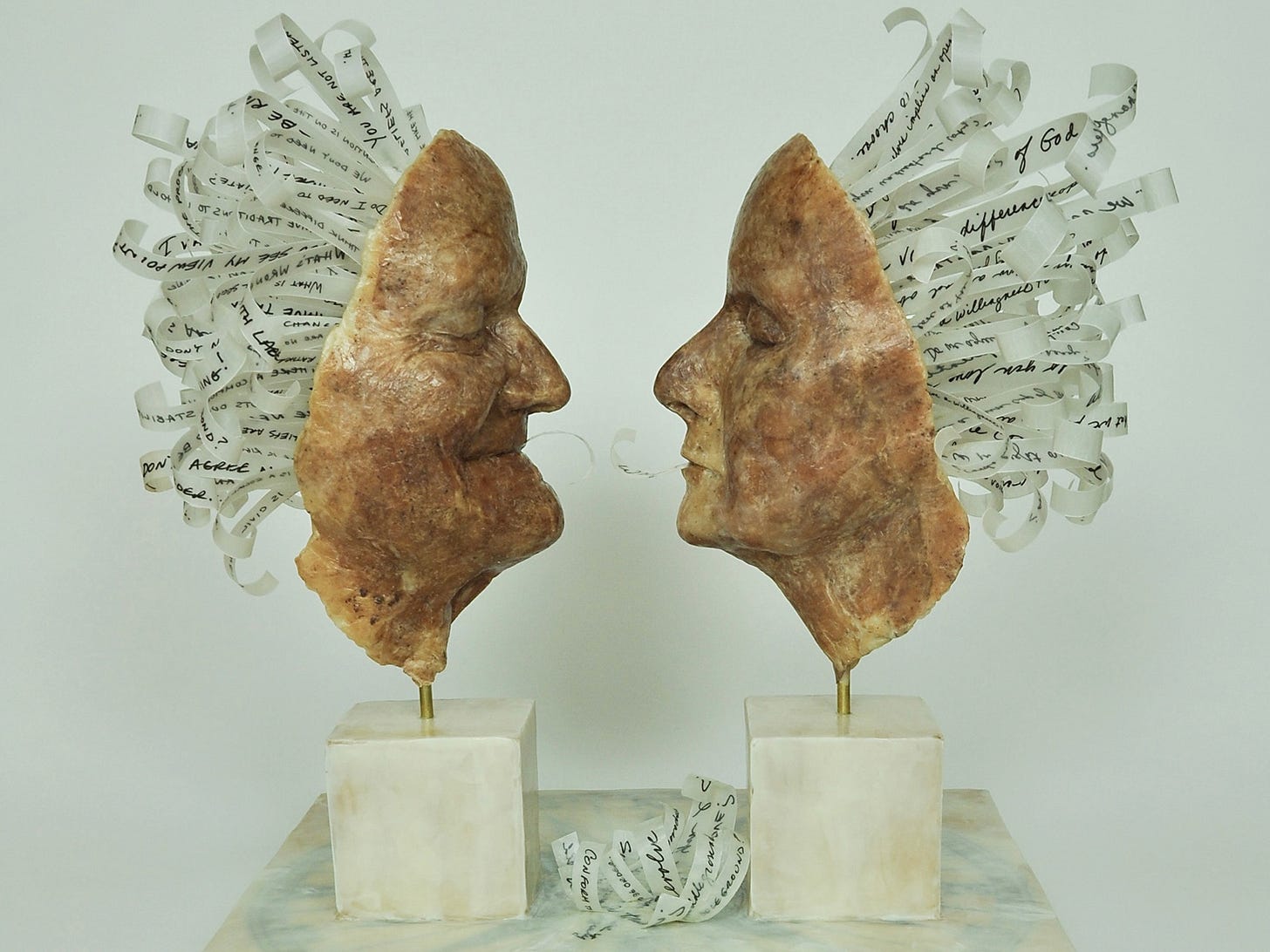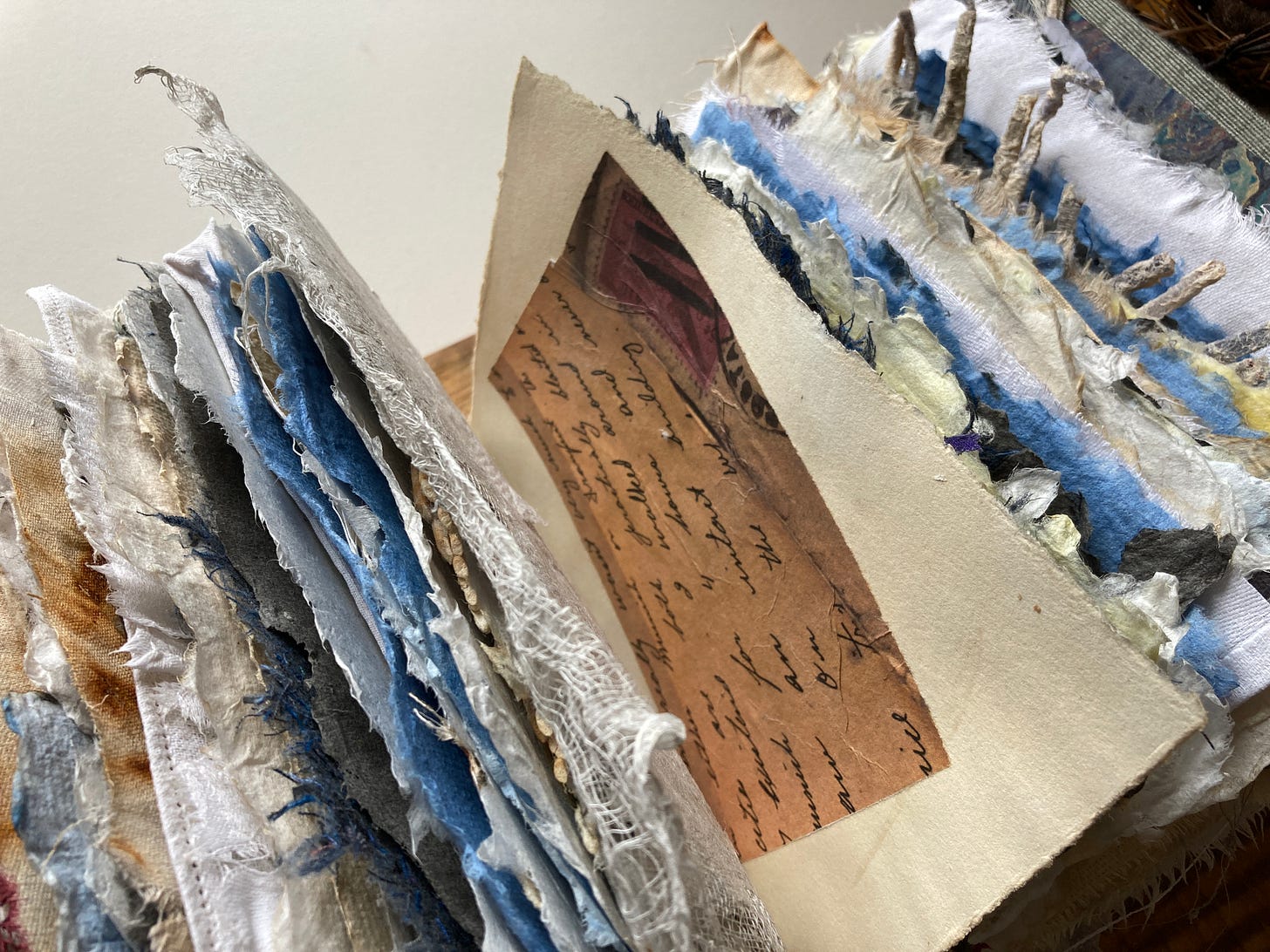It’s a stunner of an exhibition. Mending the Spaces Between: Reflections and Contemplations opens this Friday, May 20.
It started when people at the Norwich Historical Society unearthed one large, aged Bible from their book storage room and opened it. The pages had been slashed, the inside hollowed, with what can only be described as forceful malevolence. Pasted onto the book’s endpaper was a note from then Deacon John Burton.
“This Bible was given to the South Religious Society in Norwich in the year 1817 . . . used in the church for thirty one years & then cut as you now See, (by Rogues). This notice is for the benefit of those who may chance to see the Book in All Generations yet to come.”
To answer the obvious questions, to this day no one knows who or why.
The vandalized Bible spoke to Norwich Historical Society’s Director Sarah Rooker, who saw it as an ancient symbol for modern times, when divisiveness reigns and people are filled with the kind of anger that fuels acts of disrespect and even destruction. Rooker and her team set about investigating what was going on in the town of Norwich in and around the year (1848) of the Bible’s mutilation.
Turns out there was a lot. Norwich University stood in the center of town (where Marion Cross School is now), bringing students from both Northern and Southern parts of the United States together just as the Union was falling apart. There were typical town-gown tensions that resulted in sophomoric pranks and rather vile expositions: two deacons from the Norwich Congregational Church (the original home of the Bible) were hung in effigy. The Underground Railroad was likely operating in some degree even while some students brought their pro-slavery views with them to the school. Newspapers abounded: both pro- and anti-slavery papers could be found at the village post office. The introduction of the actual railroad added a layer of cultural change and therefore uncertainty.
In addition to relationships being fraught for political and religious reasons, the population of Norwich was drinking a lot of alcohol, mostly rum. The exhibition displays the accounts of the Baxter-Newton store where one put down a deposit on an earthenware rum jug and refilled it as needed, possibly while running into Deacon Morris expounding on the virtues of temperance. One prominent and unlucky citizen, Daniel Abbot, was “excommunicated” for excessive alcohol use.
One room of the exhibition is devoted to the story of this time in Norwich’s not altogether bucolic history. The viewer can take it in and render a judgment about the most likely reason for the Bible’s destruction by casting a colored wooden marble into the proper container. We’ll await the results.
Other rooms are filled with the works of twenty-two local artists who signed on to create a response to the vandalized Bible. Most honed in on our present day difficulties in speaking and listening to one another. In addition to her piece, Broken Conversations, Carla Kimball offers a remedy of sorts with Story Cards that viewers are invited to pick up and share with someone else. Stephanie Wolff shows the United States literally hanging by threads. Tracy Smith presents a sheaf of handmade papers that one is welcome to touch in History: Reflections Unbound, (photo just above). Mon Kaczyk offers Perspectives, a multi-media sculpture of two demi-heads addressing each other, their thoughts curling around in their respective brains. (Photo, top).
If for no other reason to visit, the Bible alone is worth your time. It’s formidable in size, a volume that requires both arms to pick it up. I made a conscious decision not to include a photo of it here, partly out of respect for the sacredness in which others may hold it. Mostly though, I just thought people should actually see it; a photo would be a weak imitation and would rob it of its considerable power in situ. I was drawn deeply into its presence, its age, and its seemingly senseless mutilation. Standing next to it, your fingers will itch to caress it as if to somehow make amends.
———————
Dates: May 20– November 30, 2022
Exhibit open Wednesdays, Thursdays, and Sundays from 1 – 4 pm.
Exhibit Opening Reception: May 20, 5:00 – 7:00 pm
Exhibit Open House: May 22, 1:00 – 4:00 pm
Location: Norwich Historical Society, 277 Main Street, Norwich, VT 05055
————————————————-
Welcome! You’re reading Artful, a blog about arts and culture in the Upper Valley, and I hope you’ll subscribe and then share this with your friends and on your social media. And in case you are wondering . . .
Susan B. Apel shuttered a lifelong career as a law professor to continue an interest (since kindergarten) in writing. Her freelance business, The Next Word, includes literary and feature writing; her work has appeared in a variety of lit mags and other publications including Art New England, The Woven Tale Press, The Arts Fuse, and Persimmon Tree. She connects with her neighbors through Artful, her blog about arts and culture in the Upper Valley. She’s in love with the written word.


